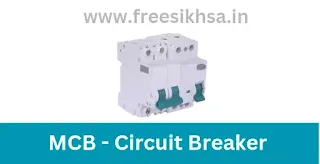What is Miniature Circuit Breaker (MCB)
A Miniature Circuit Breaker (MCB) is an electrical switch designed to automatically shut off the electrical circuit in case of an overload or short circuit. It is a type of circuit breaker that is commonly used in residential, commercial, and industrial applications.
MCBs are compact in size and can be easily installed in a panel board. They come in various sizes and ratings to suit different electrical loads. The basic function of an MCB is to protect the electrical circuit from damage caused by over currents or short circuits.
When an MCB detects an overcurrent or short circuit, it quickly trips, interrupting the flow of electricity to the circuit. This helps prevent damage to the electrical system, such as electrical fires, which can occur due to overheating caused by excessive current flowing through the wires.
MCBs are a popular choice for electrical protection as they are reliable, easy to install, and cost-effective. They have largely replaced the older style of fuse protection due to their improved performance and convenience.
Uses Of MCB
Miniature Circuit Breakers (MCBs) are used in a variety of applications in residential, commercial, and industrial settings. Some common uses of MCBs are:
- Protection of Electrical Circuits: MCBs are primarily used to protect electrical circuits from damage caused by over currents, short circuits, and other electrical faults. They are used to prevent electrical fires and damage to electrical equipment.
- Control of Electrical Load: MCBs are used to control the amount of electrical load that can be safely carried by a circuit. They can be used to limit the amount of current flowing through the circuit, thus preventing electrical overload.
- Electrical Distribution: MCBs are used to distribute electricity in electrical panels or distribution boards. They provide individual circuit protection, allowing for easy isolation and repair of any faulty circuits.
- Motor Protection: MCBs are used to protect motors from damage due to overloading or short circuits. They are often used in conjunction with other protection devices such as thermal overload relays.
- Renewable Energy Systems: MCBs are used in renewable energy systems such as solar panels and wind turbines to protect the electrical circuit and equipment from overloading or short circuits.
Conclusion, MCBs are an essential component of modern electrical systems, providing protection and control to ensure safe and reliable operation.
Specifications of Miniature Circuit Breakers (MCBs)
The specifications of Miniature Circuit Breakers (MCBs) can vary depending on the manufacturer and the specific model, but some common specifications include:
- Current Rating: MCBs are available in a range of current ratings, typically from 1 ampere (A) to 63 amperes (A). The current rating of an MCB should be selected based on the maximum current that the circuit will carry.
- Breaking Capacity: The breaking capacity of an MCB is the maximum fault current that it can safely interrupt without causing damage to the circuit or the MCB itself. It is typically rated in kiloamperes (kA) and ranges from 3 kA to 10 kA or more.
- Trip Curve: MCBs are available in different trip curves, which determine the speed at which they will trip in response to an overcurrent or short circuit. The trip curve is specified as B, C, or D, with B being the slowest and D being the fastest.
- Number of Poles: MCBs can have one, two, three, or four poles, depending on the number of phases in the electrical system. Single-pole MCBs are used for single-phase circuits, while multi-pole MCBs are used for three-phase circuits.
- Operating Voltage: MCBs are designed to operate at specific voltage levels, typically 230V AC or 415V AC.
- Endurance: The endurance of an MCB refers to its ability to withstand repeated tripping without damage. It is specified in terms of the number of operations and can range from a few thousand to tens of thousands of operations.
- Ambient Temperature: The ambient temperature range within which an MCB can operate effectively without tripping prematurely is an important specification. This range can vary between -5°C to 60°C depending on the specific MCB model.


